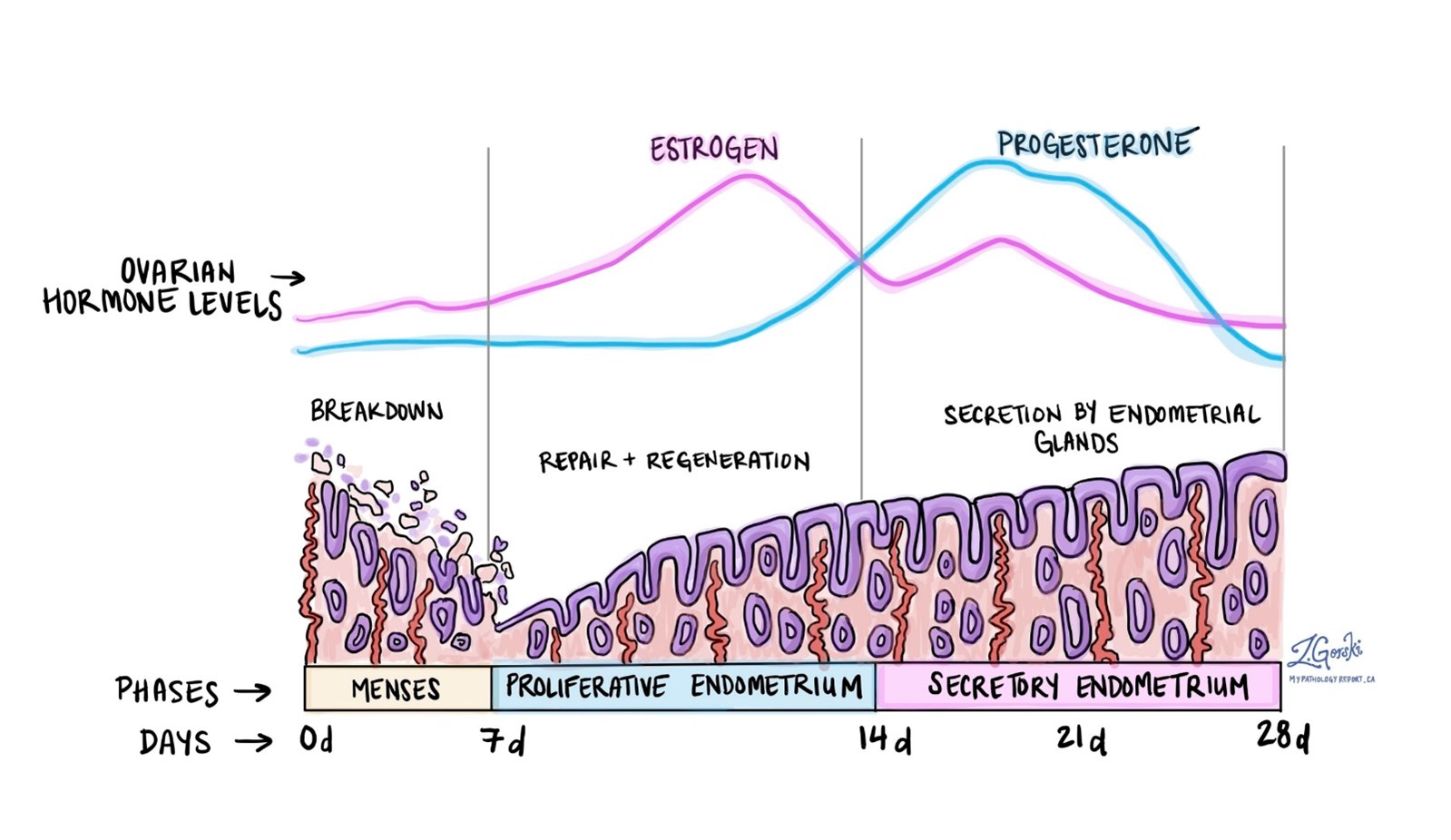When describing the menstrual cycle to a group of young women, the nurse explains that estrogen levels are highest during which phase of the endometrial cycle?
Menstrual
Ischemic
Secretory
Proliferative
The Correct Answer is D
Choice A: Menstrual is not the correct answer because it is the phase when estrogen levels are lowest. The menstrual phase occurs when the endometrium (the lining of the uterus) is shed along with blood and mucus through the vagina.
Choice B: Ischemic is not the correct answer because it is the phase when estrogen levels are decreasing. The ischemic phase occurs when the blood supply to the endometrium is reduced due to vasoconstriction (narrowing of blood vessels). This phase prepares the endometrium for shedding if fertilization does not occur.
Choice C: Secretory is not the correct answer because it is the phase when progesterone levels are highest. The secretory phase occurs when the endometrium becomes thick and spongy due to increased secretion of mucus and glycogen (a form of sugar). This phase provides a suitable environment for implantation if fertilization occurs.
Choice D: Proliferative is the correct answer because it is the phase when estrogen levels are highest. The proliferative phase occurs when the endometrium regenerates and grows due to increased stimulation by estrogen. This phase prepares the endometrium for implantation if fertilization occurs.

Nursing Test Bank
Naxlex Comprehensive Predictor Exams
Related Questions
Correct Answer is B
Explanation
Choice A: "If your sexual partner has no symptoms, no medication is needed." This statement is false and misleading. Chlamydia is a sexually transmitted infection (STI) that can cause serious complications such as pelvic inflammatory disease (PID), infertility, ectopic pregnancy, and chronic pelvic pain if left untreated. Chlamydia can also be passed on to newborns during delivery, causing eye infections or pneumonia. Therefore, it is important that both the client and their sexual partner(s) receive treatment and abstain from sexual activity until they are cured.
Choice B: "This infection is treated with one dose of azithromycin." This statement is true and accurate. Azithromycin is an antibiotic that can effectively treat chlamydia with one oral dose. However, some people may experience side effects such as nausea, vomiting, diarrhea, or abdominal pain after taking azithromycin. Therefore, it is important that the client follows the instructions and completes the treatment as prescribed.
Choice C: "You need to return in 6 months for retesting." This statement is false and unnecessary. Retesting for chlamydia is recommended only if the client has symptoms, has a new or multiple sexual partner(s), or is pregnant. Otherwise, retesting is not required if the client and their partner(s) have completed the treatment and have no further exposure to chlamydia.
Choice D: "You have to avoid sexual relations for 3 days." This statement is false and insufficient. The client should avoid sexual relations until they and their partner(s) have completed the treatment and have no symptoms of chlamydia. This may take longer than 3 days, depending on the type and duration of the treatment. Therefore, it is advisable that the client uses condoms or abstains from sexual activity until they are cured.
Correct Answer is ["20"]
Explanation
- To find out how many gtt/min to set for a manual IV infusion, we need to use this formula: gtt/min = (mL/hr x drop factor) / 60
- In this formula, mL/hr is the rate of infusion in milliliters per hour, drop factor is the number of drops per milliliter for a specific IV tubing, and 60 is the number of minutes in an hour.
- We plug in the given values into this formula: gtt/min = (120 mL/hr x 10 gtt/mL) / 60
- We simplify and solve this equation: gtt/min = (1200 gtt/hr) / 60
- We divide both sides by 60: gtt/min = 20 gtt/hr
- We round off to the nearest whole number: gtt/min = **20**
- We add a leading zero if needed: gtt/min = **20**
- We do not add a trailing zero: gtt/min = **20**
Whether you are a student looking to ace your exams or a practicing nurse seeking to enhance your expertise , our nursing education contents will empower you with the confidence and competence to make a difference in the lives of patients and become a respected leader in the healthcare field.
Visit Naxlex, invest in your future and unlock endless possibilities with our unparalleled nursing education contents today
Report Wrong Answer on the Current Question
Do you disagree with the answer? If yes, what is your expected answer? Explain.
Kindly be descriptive with the issue you are facing.
